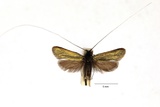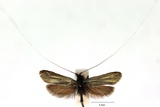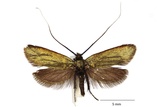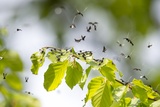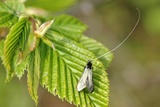Adela reaumurella (Linnaeus, 1758) Species
Last modified: March 22, 2025, 10:02 a.m.
A very common species throughout Belgium, often in big numbers flying around their host plants.
Details
- Classification
- Family: Adelidae > Subfamily: Adelinae > Genus: Adela > Species: Adela reaumurella
- Vernacular names
- Smaragdlangsprietmot (NL), Green Long-horn (EN), l'Adèle verdoyante (FR)
- Synonyms
- Adela viridella (Scopoli, 1763)
- First mention in Belgium
- De Sélys-Longchamps E. 1844. Énumération des insectes Lépidoptères de la Belgique. — Mémoires de la Société royale des Sciences de Liége 2: 1–35. On page 24 (as Adela reaumurella L.). view page
- Status
-
Native
Distribution
Caterpillar
White skin through which the inner organs can be seen; head capsule golden brown; thoracic plates light brown, darker at the sides.
Case
Oval case, constructed from 3–6 pairwise, identical, crescent-like pieces of leaves, 9–12 mm.
Bionomics
Oviposition takes place in or on the stem of lower plants. The young larva lives in a flat bivalved case and feeds on dead leaves of the food plant.
Hibernation as a full-grown larva. Pupation inside the case during early spring. Sometimes, some larvae grow much slower and the larval stage can last for two years. In such cases, the species hibernates in the pupal stage.
Male moths are active in the sunshine, and swarm around the tops of trees and bushes, while females stay in the undergrowth. The female flies in a steep flight into the swarm and copulation takes place in the air after which the couple descends towards the lower vegetation.
Flight periods
The adults fly in one generation a year from mid-April till the beginning of June.
Observed on
- Substrates:
- Dead leaves
The eggs are oviposited in lower plants like Impatiens. The young larva lives on the detritus of mainly Quercus and Fagus.
Habitat
Bright deciduous forests with mainly Quercus robur and Fagus sylvatica, preferably in dry and warm areas.
